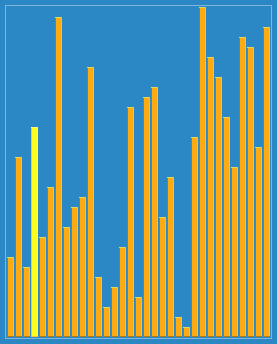Gnome sort: Difference between revisions
No edit summary |
Stack Overflow is not even close to a reliable source (irrespective of whether the provided answer is correct or not) Tag: references removed |
||
| Line 19: | Line 19: | ||
author=Paul E. Black| |
author=Paul E. Black| |
||
accessdate=2011-08-20 |
accessdate=2011-08-20 |
||
}}</ref> In practice the algorithm can run as fast as [[Insertion sort]]. The average runtime is <math>O(n^2)</math>. |
}}</ref> In practice the algorithm can run as fast as [[Insertion sort]]. The average runtime is <math>O(n^2)</math>. |
||
url=http://stackoverflow.com/questions/2066541/what-is-the-average-big--complexity-of-gnome-sort | |
|||
title=What is the Average Big-O Complexity of Gnome sort?| |
|||
work=StackOverflow |
|||
}}</ref> |
|||
The algorithm always finds the first place where two adjacent elements are in the wrong order, and swaps them. It takes advantage of the fact that performing a swap can introduce a new out-of-order adjacent pair only right before or after the two swapped elements. It does not assume that elements forward of the current position are sorted, so it only needs to check the position directly before the swapped elements. |
The algorithm always finds the first place where two adjacent elements are in the wrong order, and swaps them. It takes advantage of the fact that performing a swap can introduce a new out-of-order adjacent pair only right before or after the two swapped elements. It does not assume that elements forward of the current position are sorted, so it only needs to check the position directly before the swapped elements. |
||
Revision as of 18:10, 20 January 2012
The topic of this article may not meet Wikipedia's general notability guideline. (December 2011) |
This article needs additional citations for verification. (August 2010) |
 Visualisation of gnome sort. | |
| Class | Sorting algorithm |
|---|---|
| Data structure | Array |
| Worst-case performance | |
| Best-case performance | |
| Average performance | |
| Worst-case space complexity | auxiliary |
| Optimal | No |
Gnome sort, originally proposed by Hamid Sarbazi-Azad in 2000 and called Stupid sort, and then later on described by Dick Grune and named "Gnome sort",[1] is a sorting algorithm which is similar to insertion sort, except that moving an element to its proper place is accomplished by a series of swaps, as in bubble sort. It is conceptually simple, requiring no nested loops. The running time is O, but tends towards O(n) if the list is initially almost sorted.[2] In practice the algorithm can run as fast as Insertion sort. The average runtime is .
The algorithm always finds the first place where two adjacent elements are in the wrong order, and swaps them. It takes advantage of the fact that performing a swap can introduce a new out-of-order adjacent pair only right before or after the two swapped elements. It does not assume that elements forward of the current position are sorted, so it only needs to check the position directly before the swapped elements.
Description
Here is pseudocode for the gnome sort using a zero-based array:
procedure gnomeSort(a[])
pos := 1
while pos < length(a)
if (a[pos] >= a[pos-1])
pos := pos + 1
else
swap a[pos] and a[pos-1]
if (pos > 1)
pos := pos - 1
else
pos := pos + 1
end if
end if
end while
end procedure
Example
Given an unsorted array, a = [5, 3, 2, 4], the gnome sort would take the following steps during the while loop. The "current position" is highlighted in bold:
| Current array | Action to take |
|---|---|
| [5, 3, 2, 4] | a[pos] < a[pos-1], swap: |
| [3, 5, 2, 4] | a[pos] >= a[pos-1], increment pos: |
| [3, 5, 2, 4] | a[pos] < a[pos-1], swap and pos > 1, decrement pos: |
| [3, 2, 5, 4] | a[pos] < a[pos-1], swap and pos <= 1, increment pos: |
| [2, 3, 5, 4] | a[pos] >= a[pos-1], increment pos: |
| [2, 3, 5, 4] | a[pos] < a[pos-1], swap and pos > 1, decrement pos: |
| [2, 3, 4, 5] | a[pos] >= a[pos-1], increment pos: |
| [2, 3, 4, 5] | a[pos] >= a[pos-1], increment pos: |
| [2, 3, 4, 5] | pos == length(a), finished. |
Optimization
The gnome sort may be optimized by introducing a variable to store the position before traversing back toward the beginning of the list. This would allow the "gnome" to teleport back to his previous position after moving a flower pot. With this optimization, the gnome sort would become a variant of the insertion sort.
Here is pseudocode for an optimized gnome sort using a zero-based array:
procedure optimizedGnomeSort(a[])
pos := 1
last := 0
while pos < length(a)
if (a[pos] >= a[pos-1])
if (last != 0)
pos := last
last := 0
end if
pos := pos + 1
else
swap a[pos] and a[pos-1]
if (pos > 1)
if (last == 0)
last := pos
end if
pos := pos - 1
else
pos := pos + 1
end if
end if
end while
end procedure
References
- ^ http://www.dickgrune.com/Programs/gnomesort.html
- ^ Paul E. Black. "gnome sort". Dictionary of Algorithms and Data Structures. U.S. National Institute of Standards and Technology. Retrieved 2011-08-20.




